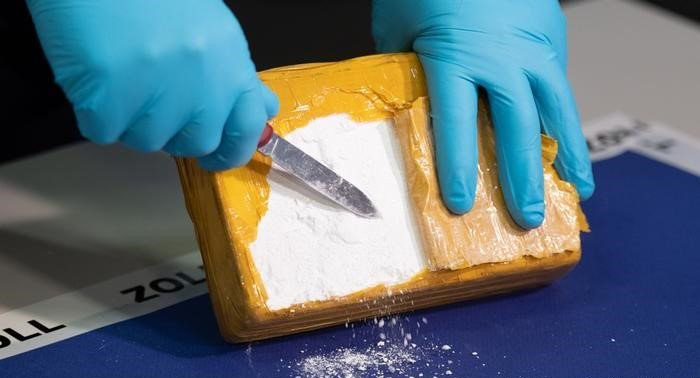The container of rice in which German authorities found a large amount of cocaine last week originated from a mill in Berbice and the rice board says all Standard Operating Procedures (SOPs) were followed during the processing of the shipment.
In a press release issued yesterday, the Guyana Rice Development Board (GRDB) said that it cannot be held responsible for the stashing of the cocaine.
“The GRDB is surprised that any suggestion has been made placing any responsibility at its door. GRDB is not a police enforcement agency and does not participate in crime investigation, prevention or enforcement. It does not check for drugs,” the agency said.
The shipment departed Guyana on May 26th and its final destination was Poland, the GRDB said.
According to the agency, records shows that the shipment of rice originated from a rice mill in Berbice and was consigned to a company, FHU KONPACK.
“The rice was transported by more than one truck from Berbice to the Georgetown wharf, and the rice was loaded onto the containers at the wharf by labourers, a process which takes several hours,” the GRDB said.
The agency noted that its responsibility ends after fumigation is completed.
“Fumigation, which is also part of GRDB’s SOPs, was done after the container was fully loaded, in the presence of a National Plant Protection Organization (NPPO) officer. The container was then locked by the shippers’ representative and all seals were placed on the containers by the shipper’s representative. The serial numbers where then recorded by the GRDB officer,” the statement explained.
“After the container is fumigated, and the shipping line seal and GRDB’s fumigation sticker is placed on the container, GRDB’s responsibilities end,” it added.
GRDB further explained that after the containers were loaded and the fumigant was applied, the containers were sealed and records also show that the containers were scanned by Customs authorities on 21st- 22nd May, 2020 before being loaded onto the ship.
GRDB said that it is tasked with inspecting random samples of rice at the mill and at the point of loading onto the container at the wharf, in order to ascertain the quality of the rice. “GRDB’s function is to grade the quality of rice (size of grains and moisture content of cargo) and to ensure that a standard quality of rice is (exported),” it said.
The vessel the rice was loaded on was MV Asiatic Wind on May 25th, 2020 and departed Guyana the following day. The final destination for the rice was Poland,” the statement noted.
According to GRDB, the vessel arrived at Caucedo, Dominican Republic on June 7th, 2020 and was discharged on the same day. “Containers (were then) loaded on a vessel titled CMA CGM Jean Gabriel on June 13th, 2020. It departed Caucedo, Dominican Republic on the same day and arrived in Hamburg, Germany on June 27th, 2020 and was discharged the following day,” GRDB said.
The agency stated that the officer on duty at the time confirmed that all of its SOP’s were followed. “The containers were inspected and checks were made in keeping with the Operating Procedures,” it said.
It is not clear whether law enforcement authorities believe that the cocaine was packed in Guyana or possibly in the Dominican Republic where the container was transferred to another vessel.
Authorities in Hamburg earlier this week announced that they were probing the discovery of 1.5 tonnes of cocaine in the container of rice from Guyana.
Detailed
The GRDB statement yesterday was released days after Minister of Agriculture Zulfikar Mustapha had requested a “detailed” report from the agency on the find.
“I have asked the manager of GRDB to provide me with a detailed report so that I can brief the President…. I am very concerned….those things will affect our exports and we will have to put measures in place to avoid (a) future reoccurrence of those things but it’s very, very serious,” Mustapha had told a virtual press conference on Tuesday.
Mustapha had said that the discovery can affect the country’s exports and measures will have to be implemented in order to avoid any future recurrence.
According to a Deutsche Welle report on Monday, the seizure was made after investigators at the Joint Customs and Police Investigation Group (JIT) reportedly received a tip-off about drug smuggling.
The cocaine which has an estimated street value of around €300 million (US$353 million) was hidden between sacks of rice in the container, the Hamburger Abendblatt newspaper said.
It is one of the largest quantities ever seized in the northern German port city, a spokesperson of the Customs Investigations Office said. “The 1.5 tons of cocaine seized may be a highly pure drug, which would be tripled in price for street sales,” the Hamburger Abendblatt quoted an official as saying.
The container, according to the report was to be loaded onto a feeder ship together with eleven other transport containers and then ultimately transported to Poland. As a result, it was temporarily stored at the Hamburg terminal.
Local authorities including CANU and the Guyana Police Force are also said to be investigating the discovery.
CANU Head, Major General (Ret’d.) Michael Atherly yesterday said that further investigations are ongoing into the discovery.
The Deutsche Welle report had said all of the parcels had various symbols on them including a cat’s face, the Gallic rooster, and the Ampelmännchen (red and green traffic light symbols shown on pedestrian signals in Germany). Several hundred of the packages were marked with the same logo.






